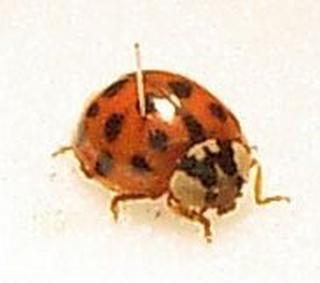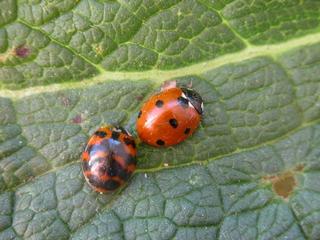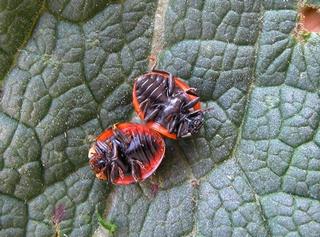
Worcestershire Record No. 21 April 2007 pp. 10-11
Compiled by Harry Green
We reported the first occurrence of the Harlequin ladybird in VC37 in Worcestershire Record No 19 November 2005, pages 14-15. This specimen was found by Brett Westwood in his Stourbridge garden, in modern West Midlands. The arrival of this species in England was discovered in September 2004 and this event excited a lot of interest as it is a voracious eater of aphids and also of other insects. A web search will give you a great deal of information! The most important current project in keeping an accurate record of the spread of the species is the national harlequin survey. A visit to this web site will give both an up-to-date distribution map and a way of sending in records. The National Biological Records Centre web site also useful as it hosts the record keeping for the survey.
www.harlequin-survey.org/ to send records and for up to date information.
www.brc.ac.uk/hostedSchemes.htm for up to date information.
The Natural History Museum web site is also useful www.nhm.ac.uk
The reason for the interest in this ladybird is well summed up on the latter web site: "An extremely voracious predator, the harlequin ladybird easily out-competes native ladybirds for its preferred food of green fly and scale insects. When these food sources are scarce they readily prey on native ladybirds and other insects such as butterfly eggs, caterpillars and lacewing larvae. The harlequin ladybird was introduced to North America from Asia to control plant pests and, 20 years later, has become North America's commonest ladybird. First spotted in the UK in September 2004, sightings have mainly been confined to the south east of Britain. ‘The harlequin is a deadly threat to our own British ladybirds’, commented Dr Michael Majerus, of Cambridge University. ‘We need to monitor them closely in order to assess the spread and impact of the insect.’”
Despite publicity we are unaware of more records in Worcestershire during 2005 and most of 2006. However a visit to the Harlequin Survey web site in early November 2006 showed records for three 10x10km squares in the east of the county. Meanwhile, there have been three new records for October 2006, and another in November near Ledbury (Herefordshire) reported below:
HERE BE MONSTERS
Gary Farmer
On 29th October 2006 I paid a visit to Croome Park (National Trust) with my children (first monsters). We had gone to follow the ‘pumpkin trail’ which allowed me time to look for bugs whilst the kids looked for clues. We stopped near one of the old buildings and I noticed a large orange ladybird ‘enjoying’ the sunshine so I knocked it onto the palm of my hand to take a closer look. There was something very unfamiliar about it so I reached for my hand lens but just at that point Count Dracular (second monster) jumped out on my kids and all hell broke loose. In the excitement ‘my’ ladybird took flight and disappeared (oh for a wooden stake). My disappointment didn’t last long as I found a second ladybird and was able to identify it as a Harlequin Ladybird. It resembled a 7-spot ladybird but with more spots and was much larger. It also had a white ‘face’ and a very distinctive large letter ‘M’ for (you guessed it) monster on the pronotum. I noticed that there were many of these, high up on the side of the building, in the sunshine. This species only arrived in Britain in 2004 (Roy et al. 2005) so the speed with which it is spreading is amazing. When it was first reported, the media claimed it to be some kind of ‘monster’ capable of wiping out our native ladybird fauna. Make a point of recording ladybirds in the county so that it may be possible to see if this new addition to the list has any real impact in the future.
 |
| Harlequin Ladybird Harmonia axridis at Croome. Picture Gary Farmer |
HARLEQUIN AT BLISS GATE, BEWDLEY
On the 31st October 2006 Rosemary Winnall sent a picture via email and wrote: I’m pretty sure this is a Harlequin Ladybird found by Nicky Winnall on the wall of our house yesterday. When she had studied it in more detail she wrote further: I have had a good look at the Harlequin and have been comparing it to a 7-spot today. The Harlequin is as large and rounder and measures 8mm from head to tail. It has a slight flange around the edge of the wing cases and the white markings look very similar to the illustration of form succinea on the new FSC pamphlet on Ladybirds of the British Isles. The underside looks quite different to the 7-spot and here is a picture of both, the Harlequin showing the orange-brown edge and not so black legs. I am not familiar with all the colour variations of the 2-spot and 10-spott, but I am sure neither of these species is as large as the Harlequin.
 |
 |
| Harlequin ladybird (left) & 7-spot ladybird (right). Picture Rosemary Winnall | Harlequin ladybird (left) & 7-spot ladybird (right). Picture Rosemary Winnall |
HARLEQUIN AT HOPE END, NEAR LEDBURY.
In November John Meiklejohn received a phone call followed by a posted packet containing a Harlequin Ladybird found on the 8th November 2006 at Hope End, near Ledbury, just in Herefordshire, which may well be the first record for that county.
KEEP LOOKING OUT
Note from John Partridge: I have not included the map from Worcestershire Record as it is already out-of-date. Clicking here will take you to the latest available.
A glance at the current map from the Harlequin Survey shows an amazing extension of distribution during the last two years. From this it seems highly likely we shall have many more records from Worcestershire in 2007 so we do appeal to recorders to keep a sharp look out and to please send in records both to Worcestershire BRC and to the national scheme. Harlequins seem to become for obvious later in the year. Apparently they are known as Halloween beetles in the US as they tend to come into houses about that time. A friend of Brett's living in London had 100's coming indoors in November. Gary Farmer’s report from Croome seems to be the first of a large autumn gathering we have seen in Worcestershire.
The species is extremely variable in colouration. The paper by Roy et al (2005) is very helpful. An “odd” ladybird the size of a 7-spot is quite likely to be a Harlequin (providing it is not an Eyed Ladybird).
| WBRC Home | Worcs Record Listing by Issue | Worcs Record Listing by Subject |